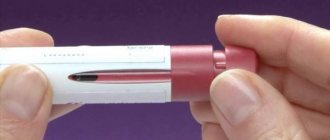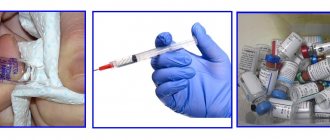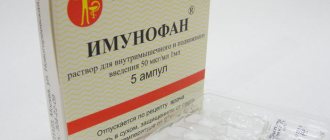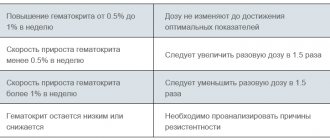Platiphylline is a medical drug that belongs to the group of m-anticholinergic blockers and has an antispasmodic and mild sedative effect on the human body. Platiphylline is available in 1 ml ampoules as a solution for parenteral administration. Externally, Platyfillin in ampoules according to the instructions for use is a colorless, transparent, odorless liquid.
This product is packaged in 10 ampoules in a cardboard box. The pack of Platyfillin contains detailed instructions for using injections, an ampoule knife or a scarifier. If the package is equipped with ampoules with points or rings for opening, then the ampoule knife is not included.
Platiphylline solution is sold in pharmacies only with a prescription from the attending physician. The drug must be stored in a place protected from light, preferably in tightly closed original packaging, at a temperature of no more than 30 degrees Celsius. The shelf life of the medicinal product in original and undamaged packaging is 5 years. The price of ampoules is on average 50 rubles per package.
Pharmacodynamics and pharmacokinetics
Platyphylline is an international name (INN) that has been adopted for use in the UK (BAN). Platyphylline is a pyrrolizidine alkaloid found in plants of the genus Senécio. The active substance of the drug is used in the form of hydrotartrate , a prescription in Latin for the substance Platyphyllini hydrotartratis, which is capable of inhibiting the cholinergic system , which transmits excitation from the parasympathetic nerves to the executive organs, thereby exerting a calming effect on the vasomotor center, and blocks the H-cholinergic receptors of the autonomic ganglia .
The drug has an anticholinergic dose-dependent effect , that is, smaller doses inhibit the secretion of the salivary and bronchial glands, sweating, eye accommodation, causing dilation of the pupils, an increase in heart rate, while large doses reduce the contractile activity of the digestive tract, including the biliary tract and gallbladder, In addition, it affects the urinary tract and inhibits gastric secretion.
As for pharmacokinetics, Platiphylline can easily pass through histohematic barriers , including the blood-brain, cellular and synaptic membranes. The correct dosage and intervals of administration do not cause accumulation of the drug, however, the administration of large doses causes its accumulation in the tissues of the central nervous system in significant concentrations. Metabolized in the liver and eliminated in the kidneys and intestines.
Platiphylline during pregnancy
At the moment, there is no accurate information about the safety of Platiphylline during pregnancy, as well as during breastfeeding (lactation). It should be borne in mind that the benefits of taking the medication for the mother must significantly exceed the risks that may arise for the child or fetus. The appropriateness of using the drug should be determined by the attending physician.
- What is vitamin E useful for in capsules? Beneficial properties of vitamin E for women and men
- Antibiotic Augmentin - for children and adults. How to take the antibiotic Augmentin for treatment, video
- Mir Sberbank card: pros and cons of the payment system
Indications for use of Platiphylline
Used for:
- spasms of smooth muscles of internal organs ( pylorospasm , intestinal, renal or biliary colic );
- for stomach and duodenal ;
- cholecystitis or cholelithiasis ;
- for acute or other chronic types of pancreatitis;
- for bronchial asthma or laryngospasms ;
- for arterial hypertension , angina pectoris , spasms of cerebral arteries and angiotrophoneurosis as part of combination therapy.
For diagnostic purposes, Platiphylline is used to dilate the pupil , in examining the fundus , in determining the true refraction of the eye, acute inflammatory diseases of the eyes, inflammation of the iris , keratitis and other eye injuries.
Side effects
Dry mouth and thirst , difficulty urinating or urinary retention, paresis of accommodation (ciliary muscle of the eye), central nervous system excitement, dizziness , dilated pupils, headaches , convulsions , photophobia , acute psychosis , from the cardiovascular system - tachycardia . pulmonary atelectasis may occur .
The likelihood of adverse reactions increases with high doses of Platiphylline.
Instructions for use of Platiphylline (Method and dosage)
It must be used parenterally (subcutaneously, intramuscularly), rectally, and in ophthalmology - topically.
Platiphylline injections, instructions for use
Use 2–4 mg 3 times a day. The maximum permissible single dose is no more than 10 mg, while the daily dose is 30 mg. The dose is determined depending on the indications, route of administration and age of the patient.
For pancreatitis is prescribed subcutaneously 1-2 ml over 12 hours during periods of intense pain to reduce spasm of the smooth muscles of the pancreas.
Platyfillin tablets, instructions for use
Take 1 tablet orally 2 or 3 times a day.
Reviews about Platifilin
Most of the available reviews about the drug confirm its high degree of effectiveness. At the same time, both doctors and patients in their reviews indicate that caution must be exercised when carrying out treatment.
Doctors in their responses about the drug categorically do not recommend self-medication with Platifilin. The therapy process should be supervised by a competent doctor who is able to correctly regulate the dosage used.
Patients indicate that even the slightest dosage violation leads to a large number of side effects and unwanted reactions
According to reviews, Platyphylline, if all recommendations are followed, rarely causes side effects in young patients; mainly, adverse reactions can occur in elderly patients.
During treatment with Platyphylline, according to reviews, it is necessary to refrain from driving. Carrying out drug therapy and performing work that requires increased attention are incompatible.
Overdose
Paralytic intestinal obstruction , urinary retention, paralysis of accommodation, increased eye pressure, dry mucous membranes of the mouth, nose and throat, which can cause difficulty swallowing, mydriasis until the iris disappears completely, tremor , convulsions , hyperthermia , excitation of the central nervous system with subsequent depression of it, as well as respiratory and vasomotor centers.
As a treatment forced diuresis , cholistenase inhibitors such as Physostigmine , Galantamine or Proserin , which can ease intestinal paresis and reduce tachycardia.
In cases of moderate agitation and weak convulsions, it is best to administer Magnesium sulfate , but in severe cases - sodium hydroxybutyrate , oxygen therapy and artificial ventilation.
If tachycardia threatens the patient’s life, then quinidine sulfate and Propranolol .
Pharmacological group
According to the instructions for use, Platiphylline is a m-cholinergic receptor blocker. It has a pronounced antispasmodic and moderate sedative effect. Taking the drug reduces the secretion of the bronchial, salivary, lacrimal and sweat glands, also dilates the pupils, and causes moderate paralysis of accommodation. The principle of action of the drug is aimed at blocking m-cholinergic receptors, which allows one to obtain the following therapeutic effect from the use of the drug:
- dilates blood vessels;
- reduces smooth muscle tone;
- improves the conductivity of cardiac muscle tissue;
- stabilizes myocardial excitability;
- reduces blood pressure;
- normalizes the secretion of glandular tissue of the bronchi.
The drug has a myotropic effect, relieves muscle tension, relieves and reduces pain. Due to its relaxing effect, administration or administration of the drug restores smooth muscle tone.
Interaction
Indications for the use of Platiphylline should take into account the presence of diseases that require regular use of other medications. When used simultaneously with the following substances, reactions may occur:
- Haloperidol - Antipsychotic effect may be reduced in patients with schizophrenia .
- Proserin - Platiphylline is its antagonist.
- Phenobarbital , sodium etaminal , magnesium sulfate - increase the duration of the hypnotic effect.
- Other m-anticholinergic agents and drugs with m-anticholinergic activity (for example, Amantadine , Phenothiazine , tricyclic antidepressants, some antihistamines) – increase the likelihood of adverse reactions.
- Morphine - enhances the inhibitory effect of Platyphylline on the cardiovascular system.
- MAO inhibitors have a positive chronotropic (increased heart rate) and bathmotropic effect (increased cardiac excitability).
- Cardiac glycosides have a positive bathmotropic effect.
- Analgesics , sedatives and anxiolytics can enhance the effect of Platiphylline for pain resulting from spasm of smooth muscles.
- Antihypertensive/sedatives enhance the effect of Platiphylline in vascular spasms.
Drug interactions and special instructions
Combined use with phenobarbital, magnesium sulfate and etaminal chloride helps to enhance the hypnotic effect of the drugs. Concomitant use with other m-anticholinergic drugs increases the risk of adverse reactions.
The use of Platiphylline with morphine enhances the inhibitory effect on the cardiovascular system. Analgesics enhance the antispasmodic effect of the drug.
During treatment with Platiphylline, you must refrain from driving vehicles and other work that requires increased attention.
For children
It is recommended to use with caution if children have chronic lung diseases , since a decrease in bronchial secretion can cause thickening of secretions and the formation of plugs in the bronchi.
Children with brain damage are at risk (the drug can enhance the effects of the disease); in addition, it is not recommended to take the drug for children with Down syndrome (there is a possibility of unusual dilation of the pupils and increased heart rate), cerebral palsy (a more pronounced reaction to the anticholinergic effect). It is not recommended to give Platiphylline injections to children under 15 years of age.
Contraindications
Solution for subcutaneous administration
- Heart failure stage II-III;
- Angle-closure glaucoma;
- Severe atherosclerosis;
- Cachexia;
- Arrhythmias;
- Tachycardia;
- Prostatic hyperplasia;
- Diaphragmatic hernia combined with reflux esophagitis;
- Renal and/or liver failure;
- Pyloroduodenal stenosis;
- Intestinal atony;
- Paralytic ileus;
- Megacolon occurring with ulcerative colitis;
- Bleeding from the gastrointestinal tract;
- Elderly and senile age;
- Hypersensitivity to the components of the drug.
Pills
- Age up to 6 years;
- Elderly and senile age;
- Hypersensitivity to the components of the drug.
Prescribing Platiphylline in any dosage form requires caution in the presence of the following diseases/conditions:
- Increased body temperature (due to the risk of further increase, which is associated with suppression of the activity of the sweat glands);
- Preeclampsia (due to a possible increase in arterial hypertension);
- Down syndrome (due to possible unusual dilation of the pupils and increased heart rate);
- Infantile central palsy (due to increased likelihood of more severe reactions to therapy);
- Xerostomia (due to the risk of increasing its severity with prolonged therapy);
- Myasthenia gravis (due to the possibility of worsening, which is associated with inhibition of the action of acetylcholine);
- Diseases of the digestive system accompanied by obstruction: achalasia and pyloric stenosis (due to a possible decrease in tone and motility, which leads to retention of gastric contents and obstruction);
- Thyrotoxicosis (due to possible increased tachycardia);
- Chronic lung diseases, especially in young children and weakened patients (due to a decrease in bronchial secretion, which can lead to thickening of secretions with the formation of plugs in the bronchi);
- Nonspecific ulcerative colitis (high doses of Platiphylline can lead to inhibition of intestinal motility, which increases the risk of paralytic intestinal obstruction; a severe complication such as toxic megacolon may also appear or worsen);
- Autonomic neuropathy (due to the risk of urinary retention and paralysis of accommodation);
- Diseases of the cardiovascular system in which an increase in the number of heart contractions is undesirable: arterial hypertension, chronic heart failure, mitral stenosis, atrial fibrillation, tachycardia, coronary heart disease, acute bleeding;
- Diseases that occur with increased intraocular pressure, including closed-angle and open-angle glaucoma (due to the likelihood of increased intraocular pressure, dosage regimen adjustment may be required);
- Urinary retention or the presence of indications of a predisposition to it or diseases occurring with obstruction of the urinary tract (including the bladder neck due to prostatic hypertrophy);
- Pregnancy and lactation;
- Age over 40 years (due to the risk of previously undiagnosed glaucoma).
Additionally, for Platiphylline in the form of tablets, caution should be exercised in patients with the following conditions/diseases:
- Reflux esophagitis, hiatal hernia occurring with reflux esophagitis (due to decreased motility of the esophagus and stomach and relaxation of the lower esophageal sphincter, gastric emptying may slow down and gastroesophageal reflux through the sphincter with impaired function may increase);
- Intestinal atony in weakened or elderly patients, paralytic intestinal obstruction (due to the risk of developing obstruction);
- Renal and liver failure (due to the risk of adverse reactions due to decreased excretion);
- Brain damage in children (due to the risk of increased reactions from the central nervous system);
- Prostatic hypertrophy occurring without urinary tract obstruction;
- Diabetes mellitus (if following a low-carbohydrate diet).
Analogs
Level 4 ATC code matches:
Disflatil
Aprofen
Mint tablets
Spasmol
Kuplaton
Espumisan
Espumisan Baby
Espumisan L
Espumisan 40
No-Shpa
Drotaverine Hydrochloride
Bobotik
Dill water
Pepsan-R
Sub Simplex
Spasmomen
Meverin
Metacin
Niaspam
Infacol
- Meteospasmil;
- Vinboron;
- Infacol.
Platiphylline price, where to buy
The price of ampoules (for 10 pieces in a box) averages 50 rubles, the price of Platyfillin tablets with papaverine is slightly higher - 140-180 rubles. (the package contains 10 tablets).
- Online pharmacies in RussiaRussia
- Online pharmacies in UkraineUkraine
- Online pharmacies in KazakhstanKazakhstan
ZdravCity
- Platyphylline g/t 0.005g and papaverine g/chl 0.02g tab.
No. 10 ZAO Vifitech PKP LLP 133 rub. order
Pharmacy Dialogue
- Platyphylline with papaverine (Table No. 10) Vifitech CJSC
RUB 149 order
- Platifillina g/t (amp. 0.2% 1 ml No. 10 (5x2)) DHF JSC
74 RUR order
- Platifillina h/t (amp. 0.2% 1 ml No. 10) DHF JSC
81 RUR order
show more
Pharmacy24
- Platyfillin 0.2% 1 ml No. 10 solution
50 UAH. order
PaniPharmacy
- Platifillin ampoule Platifillin g/t solution d/in. 0.2% amp. 1ml No. 10 Ukraine, Health LLC
47 UAH order
- Platifillin ampoule Platifillin g/t solution d/in. 0.2% amp. 1ml No. 10 Ukraine, Darnitsa ChAO
55 UAH order
show more
Release form and composition
Dosage forms of Platyphylline:
- Solution for subcutaneous administration: transparent, colorless (in ampoules of 1 ml with an ampoule knife, 5 or 10 ampoules in a cardboard box or 5 ampoules in blister or plastic packaging, 1 or 2 packs in a cardboard box);
- Tablets: white, round, flat-cylindrical, with a chamfer and a score dividing the tablet into 4 equal parts (10 pieces in blister packs, 1-3 packs in a cardboard box).
Composition of 1 ml solution for subcutaneous administration:
- Active ingredient: platiphylline hydrotartrate – 2 mg;
- Auxiliary component: water for injection – up to 1 ml.
Composition of 1 tablet:
- Active ingredient: platyphylline hydrotartrate – 5 mg;
- Auxiliary components: sucrose – 65 mg, potato starch – 29 mg, calcium stearate – 1 mg.






